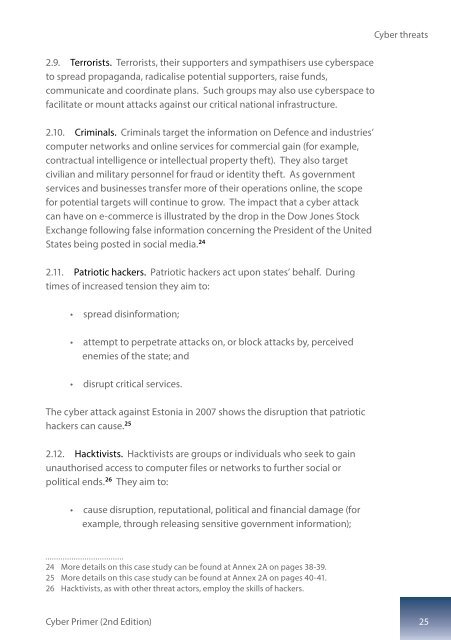Cyber Primer
AEWhbF
AEWhbF
You also want an ePaper? Increase the reach of your titles
YUMPU automatically turns print PDFs into web optimized ePapers that Google loves.
<strong>Cyber</strong> threats<br />
2.9. Terrorists. Terrorists, their supporters and sympathisers use cyberspace<br />
to spread propaganda, radicalise potential supporters, raise funds,<br />
communicate and coordinate plans. Such groups may also use cyberspace to<br />
facilitate or mount attacks against our critical national infrastructure.<br />
2.10. Criminals. Criminals target the information on Defence and industries’<br />
computer networks and online services for commercial gain (for example,<br />
contractual intelligence or intellectual property theft). They also target<br />
civilian and military personnel for fraud or identity theft. As government<br />
services and businesses transfer more of their operations online, the scope<br />
for potential targets will continue to grow. The impact that a cyber attack<br />
can have on e-commerce is illustrated by the drop in the Dow Jones Stock<br />
Exchange following false information concerning the President of the United<br />
States being posted in social media. 24<br />
2.11. Patriotic hackers. Patriotic hackers act upon states’ behalf. During<br />
times of increased tension they aim to:<br />
• spread disinformation;<br />
• attempt to perpetrate attacks on, or block attacks by, perceived<br />
enemies of the state; and<br />
• disrupt critical services.<br />
The cyber attack against Estonia in 2007 shows the disruption that patriotic<br />
hackers can cause. 25<br />
2.12. Hacktivists. Hacktivists are groups or individuals who seek to gain<br />
unauthorised access to computer files or networks to further social or<br />
political ends. 26 They aim to:<br />
• cause disruption, reputational, political and financial damage (for<br />
example, through releasing sensitive government information);<br />
24 More details on this case study can be found at Annex 2A on pages 38-39.<br />
25 More details on this case study can be found at Annex 2A on pages 40-41.<br />
26 Hacktivists, as with other threat actors, employ the skills of hackers.<br />
<strong>Cyber</strong> <strong>Primer</strong> (2nd Edition) 25


